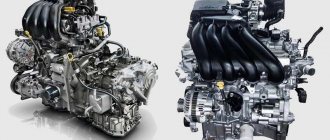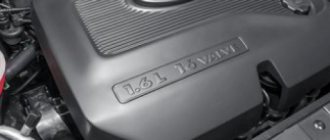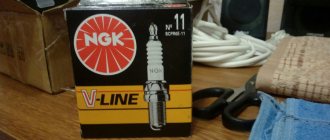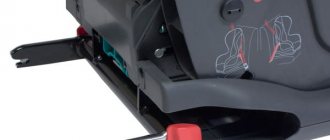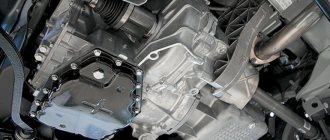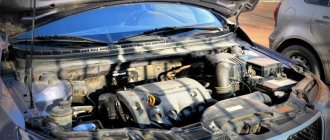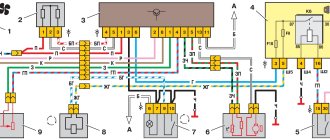Increased oil consumption with a 1.8-liter engine
Despite the fact that AvtoVAZ took a lot of time to develop the 122-horsepower engine, there are quite a lot of complaints about it: it differs not only in increased fuel consumption, but also in oil. In the latter case, we are not talking about such volumes as in some turbocharged engines, but previously VAZ power units did not sin like this, so the problem worries many car owners. Owners of the first copies complained that every 2-3 thousand km they had to add a liter of oil.
Indirectly, the manufacturer recognized the fact of oil consumption and made changes to the ECU firmware, at the same time improved the assembly process, and also modified the hardware. Now the number of complaints has decreased, but the problem has not been completely eradicated. Moreover, AvtoVAZ turns out that each engine is individual.
Body and interior
The Lada Vesta body has a certain level of corrosion protection. No minor rust was found in it. The weak point of the car is the roof. It is made of cheaper metal. The manufacturer apparently decided to do this due to the fact that the roof is damaged the least.
In early cars, the windows would scratch when lowered, but this problem was later eliminated. There are no particular problems observed inside the car. The first generation of Vesta allowed insects into the cabin. AvtoVAZ solved this problem radically by improving the fastening of interior parts. This made it possible not only to protect the interior space from “bugs”, but also to make the interior warmer.
Robotic transmission
Vesta owners complain about the AMT, or more precisely about the service life of its clutch. In the first copies, after 6-7 thousand kilometers, the “robot” responded with jerks when starting off, and when it got colder, the jerks became less noticeable. The issue is being resolved by installing a reinforced kit, but it is unknown how the new firmware for AMT, including accelerated gear shifting and a “creeping” mode, will affect the clutch life.
By the way, the same firmware solved the problems with shocks and jerks when switching: now the robotic transmission behaves much more predictably.
Front suspension creaking
This is the most common known defect that almost all Lada Vesta owners have encountered. It manifests itself when driving over uneven roads or speed bumps. The stabilizer bushings are to blame.
Now this problem is gone, as it is completely resolved. New type stabilizers with vulcanized bushings are installed.
The motor trembles during operation, vibrations and failures are noted
Much has been said about the fact that pressing the accelerator pedal is accompanied by an inadequate response, that during acceleration there are failures in engine operation, and that the engine itself often adjusts and vibrates. Official services do not see this as a malfunction; they blame low-quality gasoline, but do not want to find out the real reasons, which affects the car’s reputation. Owners are trying to cope with the problem on their own, for which they experiment with types of gasoline and the gas station itself, and replace the firmware, coils and spark plugs.
Oil getting into spark plug wells
As a result of work on the shortcomings, the VAZ 16-valve engine was made reliable. Now he doesn't cause any serious trouble. A plugless piston is installed, you can forget about the consequences of a broken timing belt.
But there was one fault remaining in the cylinder head. Owners periodically encounter it.
The head consists of 3 parts:
- Valve lid.
- Camshaft bearing housing.
- Main building.
All parts are joined together using sealant. Over time, the sealing layer is washed out, and oil begins to flow into the spark plug wells. This can be seen when replacing spark plugs if you remove the individual ignition coils. The problem is solved by disassembling the head and applying a new layer of sealant.
Knocks appear in the suspension
The service life of the levers used in the Lada Vesta suspension is generally large, but extraneous noise often comes from shock absorbers and stabilizer struts, while the latter rarely last more than 10 thousand kilometers.
Under warranty, everything changes, because diagnosing loose hinges is not difficult. AvtoVAZ itself gradually switched to reinforced elements, but before that the owners had to select analogues from foreign cars. In the case of noise from shock absorbers, the dealer will agree to replace them if oil leaks are clearly visible on them; there is no question of any checks on vibration stands, where you can get real characteristics and compare them with standard ones.
Exhaust system
Lada Vesta inherited from the VAZ-2108 and 2109 the “disease” of the exhaust system - sagging rubber bands on the muffler mounts. Owners of domestic cars claim that after 30 thousand kilometers you can hear the characteristic sound of the muffler beating against the tunnel - a sure sign of wear on the rubber elements. In rare cases, the exhaust system resonator burns out - a lifespan of about 80,000 kilometers. You can often hear from drivers how the noise of the Lada Vesta exhaust system interferes with driving. Official representatives of AvtoVAZ even gave clarifications on this matter. The thing is that both at high and low speeds, a hum, whistle and other unpleasant sounds from the muffler may appear. It may seem that the corrugation simply does not suppress the resulting vibrations. To which AvtoVAZ responded that the noise of the exhaust system is a problem for a specific car. If you encounter a similar problem, then you need to contact the dealership, where the dealer is required to fix the “jambs” under warranty.
The exhaust corrugation is rusting
Domestic cars have always had a short-lived exhaust system, and Vesta was no exception, where the corrugation rusts very quickly. At first, nothing gives this away, the sound is quite familiar, but soon the roaring car ends up being serviced. This may happen within the warranty period, so do not miss the opportunity. It is interesting that in the first years of Vesta sales, the corrugation was covered by a warranty of only 35 thousand km or a year, but after criticism it was made standard: 100 thousand km or 3 years.
What is the result: Vesta or a Korean car?
These, in principle, are all the main “childhood” diseases of the domestic sedan. Yes, the car is still crude, some may think that 520-700 thousand rubles for a car with such shortcomings is too expensive. Note that in the review of the shortcomings of the Lada Vesta, the topic of engines was not touched upon. And all because the car is equipped with fairly reliable, and most importantly, time-tested power units. In addition, Vesta’s main competitors, Kia Rio and Solaris, also have their own shortcomings, which the manufacturer has not sought to eliminate for a long time. Due to the reasonable cost and variety of trim levels, the popularity of the Russian sedan in the domestic market is growing.
In terms of the price of component parts, it will not be possible to detect a serious price difference. Spare parts for these two cars cost the same, plus or minus. For example, replacing a damaged front door will cost the owner of a domestic car 18 thousand rubles, and the owner of a Korean sedan will cost 21 thousand. The price for a Lada Vesta catalytic converter varies from 15 to 18 thousand rubles, while for a “Korean” it is around 35-38 thousand rubles. What is better and which car to buy is up to everyone to decide.
Turn signal indicators do not work
The LED turn signal indicators built into the mirrors have unsatisfactory reliability. The initial reason was poor sealing and moisture getting inside; later the repeaters began to fail on their own, not due to the fault of water. The malfunction is covered by warranty and is quickly eliminated, although previously you had to wait for the assembly of a mirror painted in the color of the body to arrive, which is not cheap and takes a long time. Currently, only the optical element can be replaced, but even if the warranty has expired, you can buy it yourself for 500 rubles and change it.
Incorrect temperature readings
You start the engine and start moving. After a couple of minutes, you notice that the antifreeze temperature gauge needle is already starting to enter the red zone. Although a little time passed, and the engine had to warm up only to operating temperature.
The cause of the malfunction is the water pump, namely its impeller, which is destroyed. Due to the lack of coolant circulation, rapid heating occurs. As a result, the system overheats. In recent releases of the Lada Vesta car this happens rarely, but still occurs.
Poor quality hood seal
For the first year or two, Vesta was supplied with a hood seal, on which the two halves were joined at the location of the lock. It was in this place that a lot of dirt got under the hood, as a result of which literally after 15 thousand kilometers the engine compartment took on a depressing appearance. Later they began to use solid rubber, but it also does not have a sizing in the center. Yes, there is less dirt, but it was not possible to completely eliminate it, so lovers of cleanliness can only “collective farm.”
Why, you ask, is there such a long break between posts? There are two reasons. The first - the red-haired Vesta went, as they say, from one hand to another: the editorial staff need to formulate their opinions about the next new product from AvtoVAZ?! And secondly, on the eve of the New Year holidays, almost all of us had more important things to do than driving a car. Lada apparently didn’t like this, so very soon our editor-in-chief Dmitry Krotov called me with “good” news: the “anti-freeze” is leaking! As they say, Happy New Year!
Rear washer operation and anti-freeze leakage:
The anti-freeze leak, fortunately, turned out to be connected not with the front, but with the rear wiper: when the rear window washer was turned on, a very modest stream sprayed from the nozzle. And from under the front right door seal, a characteristic blue puddle with a peach aroma appeared on the asphalt and on the carpet in the cabin. Therefore, as soon as the car was back in my hands, I made an appointment with the dealer for service again. True, this time to another division of Tekhinkom - closer to home (in the first division, as we remember, half of the problems were never solved...).
While the front right door is closed, most of the “anti-freeze” flows down behind the fender, and then onto the asphalt. But as soon as the door opens, the entire flow of alcohol-containing liquid flows into the interior onto the carpet
By the way, this leak is not the only problem of our Vesta Cross that was voiced to the dealer. Over the four thousand kilometers traveled by that time, the car’s handbrake “stretched out” (in order to securely fix the car in the parking lot, the lever had to be raised at least 7-8 clicks, almost resting against the end of the central armrest box) and still The front wipers jerked upward at the end of their stroke. Added to this was the key fob, whose switch blade began to jam in the folded position.
Trying to “open” the key on Vesta Cross:
The flickering of the on-board computer display on the dashboard did not go away when setting up some functions. However, on this issue we are still waiting for a response from our “native” dealer, who sent a corresponding request to the factory, so this problem was not raised this time. But the attentive master receiver found another:
A standard check of the engine oil level showed a low level - even just below the lower mark. To be honest, this came as a surprise to me, because although I had heard about oil burn on 1.8-liter VAZ engines for Vesta and XRay, I did not expect its manifestation after only four thousand kilometers.
After the technical wash, just five minutes later the technician found the cause of the anti-freeze leak. Those who were ready to “throw” another portion of brown on the fan of AvtoVAZ criticism can go and rest, because the reason turned out to be a broken tube going to the rear washer through the roof pillar. During installation of the recorder's wiring, it fell under the fastening piston of the internal decorative trim and after some time, as expected, was torn by it. This is all the more surprising and annoying because the rubber tube under the lining has special fastenings and should not dangle when it gets under the pistons. Most likely, the “human factor” manifested itself here in the form of an oversight when installing the cover after laying the power cable of the recorder.
And here is the place of the leak. Because of this, changing the entire tube is time-consuming and expensive: it’s easier to completely cut it at the break point and connect it using a 20-ruble plastic fitting
Tightening the handbrake also did not cause any difficulties (it remains to be seen whether the problem will recur...). Along the way (at our request), we were connected to power for the GPS tracker. But the twitching of the wipers was not corrected this time either. “I wouldn’t recommend doing this, so as not to damage the fasteners of the windshield wipers and subsequently lose the warranty because of this...” - to be honest, coming from the mouth of a master at an official dealer service center, this reason sounds a little strange, don’t you think? It turns out that it is better not to fix other minor breakdowns, so as not to lose the warranty?
Since the DC sells oils from Lukoil under a proprietary brand, and our car was filled with Rosneft oil from the factory, it was decided to use the latter for topping up. Moreover, the plant officially still recommends using Rosneft Maximum with a viscosity of 5W-40 or 10W-40. The required oil was found at the nearest Rosneft gas station.
The jamming of the key “sting” in the key fob was also not eliminated. It is possible that this happened due to the fact that I reported this problem after placing the work order. Without being written down on paper, the problem was simply “lost” (at the same time, the car was given out with the key in the lock, so I also missed this point when accepting the car).
More about oil. Fans of domestic motorsport know that the official partner of Lada is Rosneft, in whose colors - with a predominance of yellow - the cars of the factory circuit racing team are painted. However, the oils sold in dealership centers under the Lada brand have nothing to do with Rosneft, and their manufacturer can be easily guessed by the characteristic shape of the canisters...
Of course, when buying, albeit a Lada, but still the most modern and expensive one, you want to forget about an unscheduled service visit, at least for the duration of the warranty. And if the leakage of the antifreeze is entirely our fault, then everything else... Well, the handbrake cable shouldn’t stretch out after three thousand kilometers! And adding half a liter of motor oil (even relatively inexpensive, domestic) every three to four thousand kilometers is also not appropriate for a new engine without any technological delights. But the questions for the new station wagon do not end there: in the near future you will have to go to the dealer again and find out the cause of the knocking under the bottom during slippage. It feels like the exhaust system is poorly secured. But it is not a fact that this is the reason. So to be continued!
Best regards, Alexey A_ST
And a little more about “quality”: this is what the “original” window deflectors for Vesta SW look like (we apologize for the quality of the photo - we took it with what we had on hand)... We, of course, understand everything, but when two parts simply don’t match sizes should be the same... 
And now we will answer some questions from our readers, asked in a special form (the authors’ style has been preserved). Let’s say right away: this time we are not answering all of them: for some we will try to make an official request to the plant. For others, it is necessary to carry out additional measurements and tests. But in any case, we will try not to leave your curiosity unattended! So, let's go!
Questions from Vesta SV Cross blog readers and answers from Droma test drivers
— I bought Vesta Cross 1.6. What gearbox is it? (M)
On the Cross modification with a 1.6-liter engine, only a manual transmission developed by AvtoVAZ is installed.
— Which manual transmission is better: the Russian one, which comes with a 1.6 engine, or the French one, which comes with a 1.8 engine? In terms of noise and clarity of switching. (Michael)
It is generally accepted that the domestic gearbox is noisier. However, during the first tests we tested three different Vesta SW and SW Cross station wagons with French gearboxes. And on all the machines, slight but still audible “howls” were noted, previously characteristic exclusively of domestic gearboxes. At the same time, our editorial car with a robotic transmission, which is based on a domestic gearbox, was not noticed with such noise. As for the clarity of switching, here too the domestic transmission, in our opinion, “looks” a little better than the imported one.
— Is it possible to coast downhill on an AMT at a speed of 60–80 km/h in selector position N? (Stanislav)
Theoretically this is possible. The question is: why? This is unsafe in terms of maintaining control of the vehicle. And you won’t get any fuel savings if you don’t turn off the engine. One way or another, this action is not spelled out in the operating instructions.
— Do these cars have 4WD automatic? (Renat)
Unfortunately, there are no such modifications and are not expected in the near future.
— Why such a critical attitude towards the “robot”? Is the “robot” on a Honda Civic or Opel Astra much better, in your opinion? P.S. My friend has an Astra 1.6 on a “robot”, I have a Civic 1.8 on a “robot”. (Ilya)
Indeed, almost all of the editorial staff have a negative attitude towards the “robot” on Vesta, and this negative is directly dependent on the degree of activity when driving a car in everyday life. However, there is an opinion from authoritative racer Arkady Tsaregradtsev that Vesta’s “robot” is still at least no worse than those of foreign models in the mass segment.
— 1.8 engine — whose development? "AvtoVAZ" or does it have something to do with the 1.8 Nissan engine? (Sergey)
We talked in more detail about the VAZ-21179 engine here. Its technical characteristics can be viewed in our catalog.
— Do the mirrors fold in the opposite direction? (Efim)
Yes, they add up. But they are not fixed in this position.
— Is there air conditioning? (Andrey)
Yes, all Vesta SW station wagons are already equipped with air conditioning in the basic versions, and SW Cross is also equipped with a climate control system.
— How do you turn off the climate control on it? For example, on the Rio there is an OFF button, but on the Vesta there is NOT one, since it turns off - we just turn off the car or do we need to turn the fan to zero? Is the plastic body kit not peeling off? Floating roof - how are these linings secured? (Sergey)
Pressing the AUTO key again does not disable the automatic climate control mode: you can change the operating mode only by pressing other buttons for selecting the blowing mode or rotating the adjustment dials. Complete shutdown of the system is only possible by reducing the fan speed to zero. Regarding the body kit, we think it’s too early to draw conclusions - too little time has passed (although we haven’t heard about problems with decorative plastic on cross-versions, for example, Largus). As for the “floating roof” overlays, you can see their fastening in the photo (two metal bolts per overlay, two more bolts on each side holding the spoiler).
— Is it possible to arrange a sleeping place for two people in the car? (frequent trips across the seas, wife and child spend the night in the car)… Is the cabin suitable for family travel for a family of three or four people to relax as savages with a huge “pile” of things? (the question is more about the size of the trunk and interior)… (Evgeniy, Vladivostok)
It all depends on what conditions you are used to. It happens that they spend the night in sedans, without folding out the front seats, while others feel uncomfortable in specially designed campervans. The same applies to the suitability of the cabin for family travel: a lot depends on the amount of luggage, requirements for additional amenities, the height of passengers and even the geography of the trip... In our opinion, all this is too individual to give clear recommendations. One way or another, you can get an idea of the possibility of sleeping overnight with the rear sofa folded down in the photo below.
— I’m very interested in how the rear sofa folds, how far it folds into the floor, is it possible to then lie down in the car at full height (185 cm)? Thanks in advance (Igor)
Here you can also evaluate everything from our photographs above, as well as in comparative tests of the West station wagon with its competitors. For example, here).
— Did the designers provide space and fasteners for a fire extinguisher in the car? It’s not in a motorist’s kit to carry it! The fire extinguisher must be in an easily accessible place and always be ready to be quickly brought into “combat condition.” Approximately fire extinguisher OU-5 (its weight is approximately 13 kg) (Alexander)
Counter question: what modern mass-produced car, officially sold and having a standard place and fasteners for a five-liter (!!!) fire extinguisher, can you name as an example? We don't know such cars. Exceptions are sports cars and other specially prepared cars.
— Hello, where in the Khabarovsk Territory can Vesta be serviced so as not to lose the warranty? (Eugene)
Hello! In fact, no one has been making tin-plated bodies for a long time: nowadays galvanizing of steel external elements is in use.
